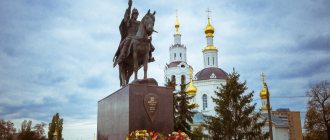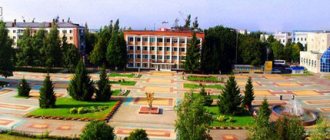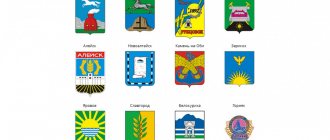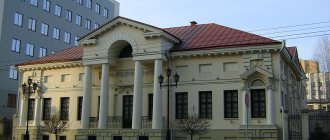Brief history of the city of Orel
The history of Orel began in 1566. It was founded as a defensive line to protect the southern parts of Russia. About the birth of the city in Nikon’s chronicle in 1566, the following words are recorded: “That same summer, by order of the sovereign Tsar and Grand Duke Ivan Vasilyevich of All Rus', a city was built on the river Orley.” Most likely, the fact of the presence of two letters E at the end of the river’s name gave rise to the speculation that the Orel River originally had the name Orlais, but it seems that this is just an elementary typo. In the “Book of the Big Drawing” it is written: “And below the Otsna river and the Rybnitsa river, the city stood on the Oka, on the left bank, Orel, and under the city on the left side the Orel river fell into the Oka.”
The history of Oryol tells us that the construction time for the fortress was extremely short; the Oryol fortress was built literally in less than a year - from the summer of 1566 to the spring of 1567.
From the point of view of military science, the choice of where to build the fortress was not entirely successful. The construction site was constantly flooded with high water and was clearly visible from the nearby high bank, which led to successful attacks on the fortress from above. Such an unfortunate location for the construction of a defensive fortress can only be explained by assuming that the fortress was built on a previously built settlement - the history of Orel is much older than is now believed.
The history of Orlu in the seventeenth century brought constant raids, robberies and devastation of European neighbors and Tatars. Since the 17th century, the history of Orel has been inextricably linked with one of the centers of the liberation movement led by Ivan Bolotnikov. In 1611 and 1615 there was a moment in history associated with the destruction of the Oryol fortress by enemy Polish troops. In 1605, the troops of False Dmitry I passed through Orel, in 1606 - Ivan Bolotnikov, in the winter of 1607-1608. Orel is the residence of False Dmitry II. In 1611 and 1615, the city was destroyed by Polish invaders; the residents of Orel were forced to leave for Mtsensk. Moreover, the very fact of the destruction of Orel did not lead to the abolition of the Oryol district. A little later, when Russia and Ukraine merged into one state, the history of Orel began with the fact that it lost its critical importance as a border defense center. Then Orel smoothly and confidently becomes the trade and cultural center of the central part of Russia and the history of Orel begins to be written anew. Peter the Great in Orel built some of the first spinning mills and manufactories in the country. From the beginning of the 18th century, a change appeared in the history of Orel again - the city was included in the Kyiv province. Later, from 1727, Orel was transferred to the Belgorod province, and from 1778 Orel had the status of the center of the Oryol governorship. Especially in the 18-19 centuries, the history of Orel was connected with the life of a huge layer of the noble and merchant population, with a large number of small handicraft enterprises, such as processing of agricultural raw materials, centers for trading bread and grain. During the difficult years of the Patriotic War of 1812, the history of Orel was connected with the most powerful movement of defenders of the homeland from the French invaders. Finally, in the history of Orel, changes towards independence were outlined when the city of Orel in 1937 became regional src=»https://www.arscomp.ru/uploads/statik_kontent/orel_1.gif» class=»aligncenter» width=»640″ height=» 480″[/img]
The days of the Great Patriotic War brought the history of Orel another difficult plot of life - Orel was captured by German troops. The post-war history of Orel began on August 5, 1943, as a result of the liberation of the city from invaders during the Battle of Kursk. After the liberation of Orel and Belgorod, Moscow gave the first artillery salute of many guns during the 1941-1945 war. In the post-war period, the history of Orel was connected for many years with the restoration of the city and region. The industrial potential of the city was greatly increased, and the history of Orel received a new twist. Orel began to become a powerful center of trade and light industry. The history of the Eagle began a new development.
The fertile lands and beautiful natural places located in Orel and the region constantly attracted landowners to Orel, and among them there were a huge number of the smartest and most famous people in Russia and the world. The history of Orel is forever intertwined with these people who brought glory, honor and respect to Russia. Probably no other history of any city in our homeland is replete with so many sonorous and famous names. The history of Orel is a rich information and cultural layer of Russia.
A little about the city
Oryol is located in the eastern part of Russia, just 370 kilometers from the capital. It belongs to the Central Economic District of the state. Local production specializes in food and beverages, metallurgy, and the production of electrical equipment and machinery.
It has existed as a city since 1566. The flag and coat of arms contain the main historical features about it and are its official symbols. The Oryol city administration approved their modern images in 1998.
This is by no means an ordinary city in the state. It is popularly famous for its delicious black bread, which has been prepared since 1960. The Liven accordion, the longest in the world, was also invented here. It contains about 40 folds, and if it is fully stretched, the size of the accordion will reach two meters. The city is also famous for its red and white embroidery called “Oryol list” with ancient Russian motifs and airy Mtsevo lace, which has not lost its relevance since the 18th century.
New symbol
In 2002, an updated flag and coat of arms of the city of Oryol was developed and approved.
The new version of the heraldic shield depicts a silver fortress with three towers and gates in the middle part, but the eagle has become golden and double-headed with three crowns. The upper part of the coat of arms is azure, the lower part is green. At the foot of the fortress lies an open book, framed on both sides by ears of corn. The development of this symbol was carried out by artists Vladimir Blinov and Givi Kolmakhelidze. Some people like the new sign for the region and its center, while others think that the old one was better. Be that as it may, the emblem remains symbolic and understandable to everyone. It is unlikely that anyone will have the following question: “Which city’s coat of arms is an eagle on a fortress in a field?” The proud bird remains the symbol and guardian of the region. And this is the most important thing.
The main symbol of the city
There is also a romantic legend telling about the origin of the name of the fortress.
During the beginning of the construction of a defensive settlement, workers were cutting down a tall oak tree standing at the confluence of the Oka and Orla rivers, and a majestic bird flew from this tree. “What was that?” one man asked another, and he answered: “And this is the owner of these places.” Having learned about this story, the king gave the go-ahead to name the city in honor of the proud eagle, hoping for the protection of the heavenly predator. However, this is just a beautiful legend. It is known for certain that the city’s coat of arms was approved on August 16, 1781. This is a blue heraldic French shield. In its central part there is a white fortified city standing on a green meadow. On the main tower, crowning the entrance gate, sits a black eagle with a golden crown on its head. What is noteworthy is that over the past years the coat of arms of the city of Oryol has not changed much. The modern symbol of this settlement is very similar to the original version.
History of the coat of arms
Just like the city flag, the coat of arms with the Eagle was not invented in 1998. It appeared much earlier, namely in 1730. At first it was used as a symbol of the Oryol Regiment. Then it was more detailed: the fortress was depicted more artistically and was crowned with red roofs, it stood on green hills, and on top of it sat an eagle with a golden crown on its head.
In 1781, the coat of arms with an eagle was approved as the official city symbol. Its style has changed somewhat, and the roofs on the fortress have become white, but the general appearance remains the same. In the 18th century it changed dramatically. The coat of arms depicted a stone fortress with three towers, above which is a golden imperial eagle with two heads and a crown above them. The heraldic shield was crowned with a gold imperial crown, and on its sides was framed by golden oak leaves intertwined with a blue St. Andrew's ribbon.
The modern appearance of the city symbol is close to the very first version, but its image style has become more schematic, and there is no crown on the bird’s head. The golden double-headed eagle and the fortress with three towers from the 18th century version now adorn the region's coat of arms.
Holy Dormition Monastery
The Holy Dormition Monastery has a rather interesting, but tragic history. Its construction dates back to 1686. Every year the number of novices increased, and the territory belonging to the monastery increased. New buildings were erected, which today would undoubtedly be included in the sights of Orel.
But with the Bolsheviks coming to power, the situation changed dramatically. The buildings of the monastery began to be used for purposes other than their intended purpose, and many were redesigned or destroyed. And after the war, a children's labor colony was organized on the territory of the former monastery. Thus, by 1980, almost all the old buildings were destroyed, except for the Trinity Church.
However, almost immediately after the collapse of the Union, attempts were made to reconstruct the Cathedral - to make it as close as possible to its former state. Already in 1996, monastic life began again in the monastery. In subsequent years, reconstruction continued, and by 2008 it was largely completed.
New symbol
In 2002, an updated flag and coat of arms of the city of Oryol was developed and approved.
The new version of the heraldic shield depicts a silver fortress with three towers and gates in the middle part, but the eagle has become golden and double-headed with three crowns. The upper part of the coat of arms is azure, the lower part is green. At the foot of the fortress lies an open book, framed on both sides by ears of corn. The development of this symbol was carried out by artists Vladimir Blinov and Givi Kolmakhelidze. Some people like the new sign for the region and its center, while others think that the old one was better. Be that as it may, the emblem remains symbolic and understandable to everyone. It is unlikely that anyone will have the following question: “Which city’s coat of arms is an eagle on a fortress in a field?” The proud bird remains the symbol and guardian of the region. And this is the most important thing.
Epiphany Cathedral
We will begin to describe the historical sights of Orel from the oldest building that has survived to this day, namely the Epiphany Cathedral. It was built in the middle of the 17th century. Of course, since then the cathedral has been rebuilt and reconstructed many times, nevertheless largely retaining its original appearance. The temple underwent the greatest changes at the very beginning of the 20th century, and the last partial reconstruction was carried out in 2013. The very next year, services were resumed in the church for the first time since 1919. Today, many tourists and parishioners flock to this cultural monument and spiritual abode.
Eagle today
Currently, Orel is the largest settlement and administrative center of the Oryol region of the Russian Federation. Its population currently exceeds three hundred thousand people. The city has a number of large industrial enterprises in the food industry, mechanical engineering, and metallurgy. The production of minerals has also been established.
But the main thing that the city of Orel can be proud of is its history and sights. This settlement literally rose from the ashes several times, thanks to the heroism and hard work of its residents. And the main attractions of Orel will be discussed below.
Eagle flag
The city flag, although it was approved in 1998, was not created from scratch. It was based on a symbol that was used in the RSFSR from 1954 to 1991. Then it was a canvas divided into two unequal vertical parts. The larger part was painted red, the smaller part was located in a stripe near the shaft and was painted blue. In the upper left corner (on the viewer's side) of the red field there were a golden sickle and hammer, and above them a golden star was depicted as an outline.
The modern version contains all the details of the Soviet flag, but other elements have been added to them. So, in the center of the red field the coat of arms of the city of Orel is depicted. What do the flag symbols mean? The sickle, hammer and star are typical signs of communism. These include the red color, symbolizing the revolutionary movement, at the same time, it is a sign of courage and courage. Blue signifies greatness, wisdom and beauty. Red and blue are present in approximately the same ratio on the flag of the Oryol region.











